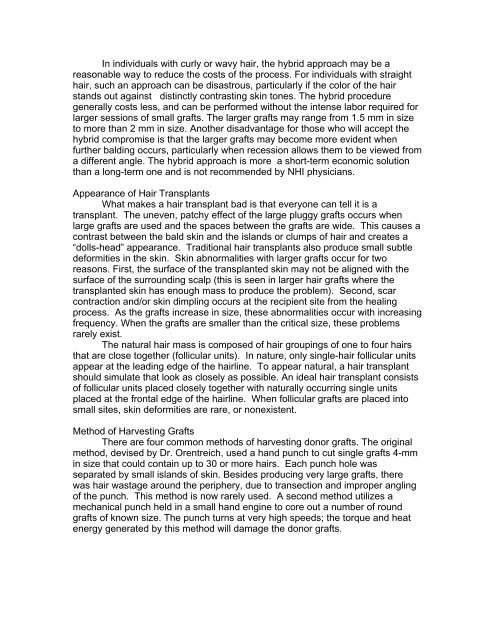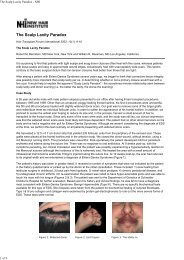The Patient's Guide to Hair Restoration - New Hair Institute
The Patient's Guide to Hair Restoration - New Hair Institute
The Patient's Guide to Hair Restoration - New Hair Institute
You also want an ePaper? Increase the reach of your titles
YUMPU automatically turns print PDFs into web optimized ePapers that Google loves.
In individuals with curly or wavy hair, the hybrid approach may be a<br />
reasonable way <strong>to</strong> reduce the costs of the process. For individuals with straight<br />
hair, such an approach can be disastrous, particularly if the color of the hair<br />
stands out against distinctly contrasting skin <strong>to</strong>nes. <strong>The</strong> hybrid procedure<br />
generally costs less, and can be performed without the intense labor required for<br />
larger sessions of small grafts. <strong>The</strong> larger grafts may range from 1.5 mm in size<br />
<strong>to</strong> more than 2 mm in size. Another disadvantage for those who will accept the<br />
hybrid compromise is that the larger grafts may become more evident when<br />
further balding occurs, particularly when recession allows them <strong>to</strong> be viewed from<br />
a different angle. <strong>The</strong> hybrid approach is more a short-term economic solution<br />
than a long-term one and is not recommended by NHI physicians.<br />
Appearance of <strong>Hair</strong> Transplants<br />
What makes a hair transplant bad is that everyone can tell it is a<br />
transplant. <strong>The</strong> uneven, patchy effect of the large pluggy grafts occurs when<br />
large grafts are used and the spaces between the grafts are wide. This causes a<br />
contrast between the bald skin and the islands or clumps of hair and creates a<br />
“dolls-head” appearance. Traditional hair transplants also produce small subtle<br />
deformities in the skin. Skin abnormalities with larger grafts occur for two<br />
reasons. First, the surface of the transplanted skin may not be aligned with the<br />
surface of the surrounding scalp (this is seen in larger hair grafts where the<br />
transplanted skin has enough mass <strong>to</strong> produce the problem). Second, scar<br />
contraction and/or skin dimpling occurs at the recipient site from the healing<br />
process. As the grafts increase in size, these abnormalities occur with increasing<br />
frequency. When the grafts are smaller than the critical size, these problems<br />
rarely exist.<br />
<strong>The</strong> natural hair mass is composed of hair groupings of one <strong>to</strong> four hairs<br />
that are close <strong>to</strong>gether (follicular units). In nature, only single-hair follicular units<br />
appear at the leading edge of the hairline. To appear natural, a hair transplant<br />
should simulate that look as closely as possible. An ideal hair transplant consists<br />
of follicular units placed closely <strong>to</strong>gether with naturally occurring single units<br />
placed at the frontal edge of the hairline. When follicular grafts are placed in<strong>to</strong><br />
small sites, skin deformities are rare, or nonexistent.<br />
Method of Harvesting Grafts<br />
<strong>The</strong>re are four common methods of harvesting donor grafts. <strong>The</strong> original<br />
method, devised by Dr. Orentreich, used a hand punch <strong>to</strong> cut single grafts 4-mm<br />
in size that could contain up <strong>to</strong> 30 or more hairs. Each punch hole was<br />
separated by small islands of skin. Besides producing very large grafts, there<br />
was hair wastage around the periphery, due <strong>to</strong> transection and improper angling<br />
of the punch. This method is now rarely used. A second method utilizes a<br />
mechanical punch held in a small hand engine <strong>to</strong> core out a number of round<br />
grafts of known size. <strong>The</strong> punch turns at very high speeds; the <strong>to</strong>rque and heat<br />
energy generated by this method will damage the donor grafts.



